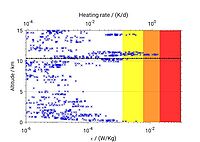Turbulence in the stratosphere
In the atmosphere, gravity waves and turbulence play a crucial role in the understanding of energy and momentum transfer as well as trace gas distribution.
Breaking gravity waves produce smaller and smaller structures down to the size of turbulence cells. In doing so, the energy contained is dissipated into heat and contributes to the local heating in the respective altitude. The lost wave energy cannot be transported further upwards into the mesosphere.
Additionally, turbulence is important for the vertical mixing of trace species.
Up to date, there are only few measurements in the stratosphere, because the availability of adequate measurement methods is low. In order to quantify turbulence precisely, the inner scale has to be resolved, i.e. the length scale on which the dissipation begins to take place. In the stratosphere, it is in the range of centimetres and below. This is only possible with in-situ techniques. For the stratosphere that reduces the choice to balloon borne systems.
Such turbulence measurements were performed sporadically in the 1980ies, but those could not yet resolve the inner scale of turbulence. At IAP, a new instrument called LITOS was developed, which can measure winds and temperatures with an unprecedented resolution of less than a millimetre.
This instrument was successfully launched several times from Kühlungsborn, Andenes (Norway) and Kiruna (Sweden). From the data, vertical profiles of dissipation rate in the troposphere and stratosphere were computed. The measurements show many turbulent layers, which are unexpectedly thin with a typical thickness of several 10 m up to a few 100 m. Even within one layer, the energy dissipation rate is highly variable. In the maximum, the dissipation rate partly grows to 1 - 10 mW/kg, i.e. turbulent heating rates of 0.1 - 1 K/d.
Selected publications
- J. Söder, C. Zülicke, M. Gerding and F.-J. Lübken, High-resolution observations of turbulence distributions across tropopause folds, J. Geophys. Res., 126(6), doi:10.1029/2020JD033857, 2021.
- A. Schneider, J. Wagner, J. Söder, M. Gerding and F.-J. Lübken, Case study of wave breaking with high-resolution turbulence measurements with LITOS and WRF simulations, Atmos. Chem. Phys., 17(12), 7941-7954, doi:10.5194/acp-17-7941-2017, 2017.
- A. Schneider, M. Gerding and F.-J. Lübken, Comparing turbulent parameters obtained from LITOS and radiosonde measurements, Atmos. Chem. Phys. Discuss., 14, 19033-19053, doi:10.5194/acpd-14-19033-2014, 2014.













